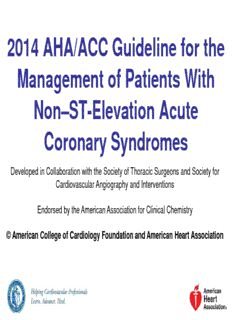Table Of Content2014 AHA/ACC Guideline for the
Management of Patients With
Non–ST-Elevation Acute
Coronary Syndromes
Developed in Collaboration with the Society of Thoracic Surgeons and Society for
Cardiovascular Angiography and Interventions
Endorsed by the American Association for Clinical Chemistry
© American College of Cardiology Foundation and American Heart Association
Citation
This slide set is adapted from the 2014 AHA/ACC Guideline for the
Management of Patients With Non–ST-Elevation Acute Coronary
Syndromes. Published on September 23, 2014, available at: Journal
of the American College of Cardiology
(http://content.onlinejacc.org/article.aspx?doi=10.1016/j.jacc.2014.09
.017) and Circulation
(http://circ.ahajournals.org/lookup/doi/10.1161/CIR.00000000000001
34).
The full-text guidelines are also available on the following Web sites:
ACC (www.cardiosource.org) and AHA (my.americanheart.org)
NSTE-ACS Guideline Writing Committee
Ezra A. Amsterdam, MD, FACC, Chair†
Nanette K. Wenger, MD, MACC, FAHA, Vice Chair*†
Ralph G. Brindis, MD, MPH, MACC, Glenn N. Levine, MD, FACC, FAHA†
FSCAI‡ Philip R. Liebson, MD, FACC, FAHA†
Donald E. Casey, Jr, MD, MPH, MBA, Debabrata Mukherjee, MD, FACC†
§
FACP, FAHA Eric D. Peterson, MD, MPH, FACC,
Theodore G. Ganiats, MD║ FAHA*#
David R. Holmes, Jr, MD, MACC† Marc S. Sabatine, MD, MPH, FACC,
Allan S. Jaffee, MD, FACC, FAHA*† FAHA*†
Hani Jneid, MD, FACC, FAHA, FSACI† Richard W. Smalling, MD, PhD, FACC,
Rosemary F. Kelly, MD¶ FSCAI* **
Michael C. Kontos, MD, FACC, FAHA*† Susan J. Zieman, MD, PhD, FACC†
*Writing committee members are required to recuse themselves from voting on sections to which
their specific relationships with industry and other entities may apply. †ACC/AHA Representative.
§
‡ACC/AHA Task Force on Practice Guidelines Liaison. American College of Physicians
Representative. ║American Academy of Family Physicians Representative. ¶Society of Thoracic
Surgeons Representative. #ACC/AHA Task Force on Performance Measures Liaison. **Society
for Cardiovascular Angiography and Interventions Representative.
Applying Classification of Recommendations and
Levels of Evidence
A recommendation with Level
of Evidence B or C does not
imply that the recommendation
is weak. Many important
clinical questions addressed in
the guidelines do not lend
themselves to clinical trials.
Although randomized trials are
unavailable, there may be a
very clear clinical consensus
that a particular test or therapy
is useful or effective.
*Data available from clinical
trials or registries about the
usefulness/ efficacy in different
subpopulations, such as sex,
age, history of diabetes,
history of prior myocardial
infarction, history of heart
failure, and prior aspirin use.
†For comparative
effectiveness
recommendations (Class I and
IIa; Level of Evidence A and B
only), studies that support the
use of comparator verbs
should involve direct
comparisons of the treatments
or strategies being evaluated.
Acute Coronary Syndromes
(top half)
Onset of NSTE-ACS Hospital Management
-Initial recognition and management in the -Medication
ED by first responders or ED personnel -Conservative versus invasive strategy
-Risk stratification -Special groups
-Preparation for discharge
-Immediate management
Secondary Prevention/
Long-Term Management
Management Prior to
NSTE-ACS
Presentation
Ischemic Discomfort
ACS
Acute Coronary Syndromes
(top half cont’d)
The top half of the figure illustrates the progression of plaque
formation and onset and complications of NSTE-ACS, with management
at each stage. The numbered section of an artery depicts the process of
atherogenesis from 1) normal artery to 2) extracellular lipid in the
subintima to 3) fibrofatty stage to 4) procoagulant expression and
weakening of the fibrous cap. ACS develops with 5) disruption of the
fibrous cap, which is the stimulus for thrombogenesis. 6) Thrombus
resorption may be followed by collagen accumulation and smooth
muscle cell growth. Thrombus formation and possible coronary
vasospasm reduce blood flow in the affected coronary artery and cause
ischemic chest pain.
Acute Coronary Syndromes
(bottom half)
Presentation
Ischemic Discomfort
ACS
Working Dx
ECG
No ST Elevation ST Elevation
NSTE-ACS
Cardiac Biomarker UA NSTEMI* STEMI*
Unstable Angina Myocardial Infarction
Noncardiac
NQMI QwMI
Final Dx Etiologies
Acute Coronary Syndromes
(bottom half cont’d)
The bottom half of the figure illustrates the clinical, pathological,
electrocardiographic, and biomarker correlates in ACS and the general
approach to management. Flow reduction may be related to a completely
occlusive thrombus (bottom half, right side) or subtotally occlusive thrombus
(bottom half, left side). Most patients with ST elevation (thick white arrow in
bottom panel) develop QwMI, and a few (thin white arrow) develop NQMI.
Those without ST elevation have either UA or NSTEMI (thick red arrows), a
distinction based on cardiac biomarkers. Most patients presenting with
NSTEMI develop NQMI; a few may develop QwMI. The spectrum of clinical
presentations including UA, NSTEMI, and STEMI is referred to as ACS. This
NSTE-ACS CPG includes sections on initial management before NSTE-
ACS, at the onset of NSTE-ACS, and during the hospital phase. Secondary
prevention and plans for long-term management begin early during the
hospital phase. Patients with noncardiac etiologies make up the largest
group presenting to the ED with chest pain (dashed arrow).
Guideline for NSTE-ACS
Initial Evaluation and Management
Clinical Assessment and Initial Evaluation
Recommendations COR LOE
Patients with suspected ACS should be risk stratified based
on the likelihood of ACS and adverse outcome(s) to decide
I B
on the need for hospitalization and assist in the selection of
treatment options.
Patients with suspected ACS and high-risk features such as
continuing chest pain, severe dyspnea,
syncope/presyncope, or palpitations should be referred I C
immediately to the ED and transported by emergency
medical services when available.
Patients with less severe symptoms may be considered for
referral to the ED, a chest pain unit, or a facility capable of
IIb C
performing adequate evaluation depending on clinical
circumstances.
Description:This slide set is adapted from the 2014 AHA/ACC Guideline for the. Management of . 6 hours after symptom onset (see Section 3.4, Class I, #3 recommendation if time of when changes on ECG and/or clinical presentation confer.

